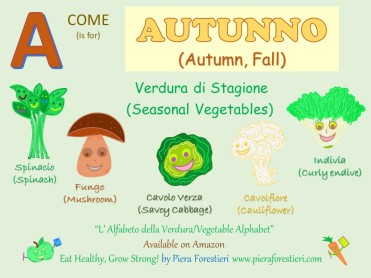
“Bontà di Stagione”/“What’s in Season?” is a lesson included in my Nutrition Education Program for the classroom “Eat Healthy, Grow Strong!”.
It’s important for children to learn that fruits and veggies grow naturally and ripen during certain seasons of the year, while in others they’re imported from other countries or grown using greenhouses.
Educating children about seasonality will help them understand origin of food, modern farming, local and sustainable food systems, and that seasonal fruits and vegetables have different taste, nutritional value and costs.
This topic links well with science and geography (weather, seasons, time, soil, etc.), grammar (new terms to describe seasons and foods), reading (write and read stories about food production), art (draw a calendar of food in season), Italian/English languages (enrich fruit and vegetable vocabulary in both languages).
Student learning can be supported by practical activities such as visiting a local farm and a supermarket to read the label and learn where the food comes from, and cook a recipe using seasonal food.
The key messages about food seasonality can be reinforced at the beginning of each season during the school year.
If you would like to receive some material and further details on how to include this topic in your school curriculum, feel free to contact me
So what’s in season for Fall?
Cosa c’ è di buono in Autunno?
“Bontà di Stagione”/“What’s in Season?” è un’ unità del mio Programma di Educazione Alimentare “Eat Healthy, Grow Strong!” (“Mangiare Sano, Crescere Forti”).
E’ importante che i bambini imparino che frutta e verdure crescono naturalmente in alcuni periodi dell’ anno, mentre in altri sono importati da altri Paesi o coltivati in serra.
Questo modulo sulla Stagionalità permetterà ai bambini di comprendere l’ origine del cibo, i sistemi di agricoltura tradizionali, locali e sostenibili, e che frutta e verdura di stagione hanno sapore, valore nutrizionale e costo diversi.
Il tema della stagionalità può essere affrontato in varie materie come scienza e geografia (clima, suolo, tempo), grammatica (nuovi termini, aggettivi), lettura (scrittura e lettura di storie legate a cibo, orto, stagioni), lingua Inglese (arricchire il vocabolario con nuove parole).
Le lezioni teoriche possono essere accompagnate con attività pratiche come visitare una locale azienda agricola, e poi un supermercato dove leggere le etichette e scoprire la provenienza di frutta e verdura, e cucinare una ricetta usando ingredienti freschi di stagione.
L’ argomento puo’ essere discusso e approfondito all’ inizio di ogni stagione durante l’ anno scolastico in modo da rinforzare e ampliare le conoscenze acquisite.
Se volete ricevere del materiale e informazioni su come includere questo argomento nel vostro curriculum scolastico, contattatemi



